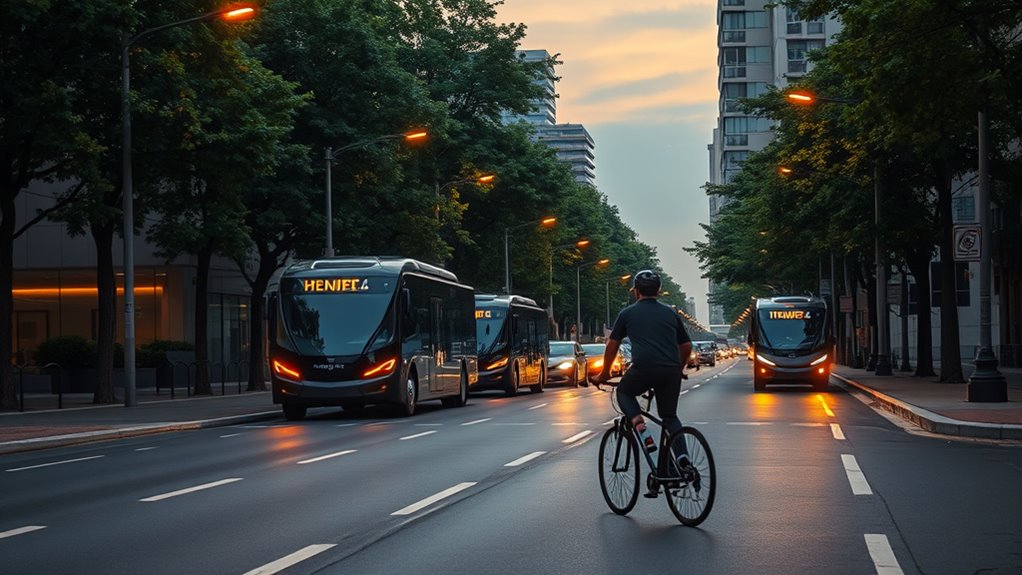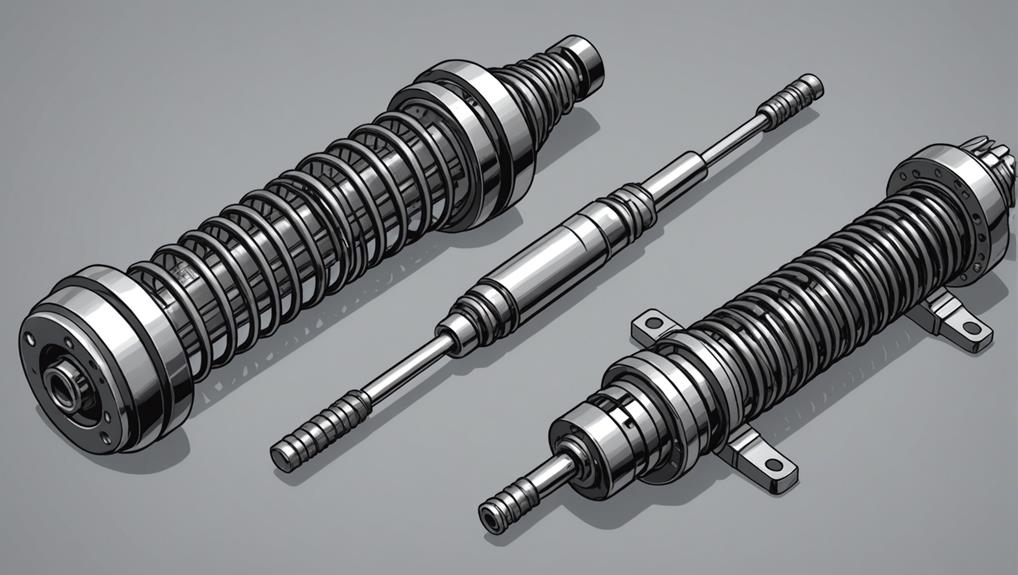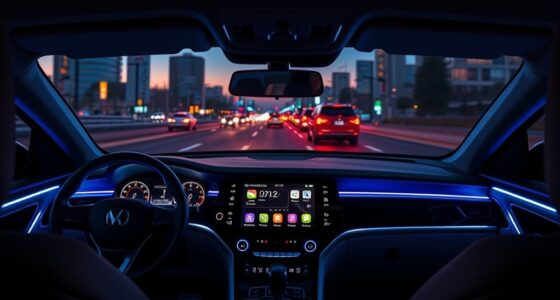Autonomous vehicles can surprisingly cut city noise in several ways. They reduce honking by relying on sensors and signals, so fewer loud horns disturb urban life. Smooth operation also cuts engine idling and abrupt stops, decreasing engine noise. Their ability to optimize traffic flow ensures fewer stops and starts, keeping noise levels lower. Plus, predictable driving behaviors minimize sudden brakes and accelerations, making streets calmer. Keep exploring to discover how these innovations continue to transform city soundscapes.
Key Takeaways
- Autonomous cars communicate silently, reducing the need for loud honks and decreasing sudden noise spikes.
- Smoother driving patterns minimize engine idling and abrupt acceleration, lowering overall traffic noise.
- Coordinated traffic flow prevents congestion, decreasing stop-and-go driving and engine noise.
- Predictable vehicle behavior reduces abrupt braking and acceleration sounds, creating a calmer sound environment.
- Enhanced traffic management leads to more consistent speeds and routes, resulting in a quieter urban atmosphere.

Autonomous vehicles are often praised for their safety and efficiency, but they also have an unexpected benefit: they can substantially reduce city noise. When you’re walking through busy streets, you probably notice the constant hum of engines, honking horns, and the clatter of brakes. Autonomous cars have the potential to change that soundscape dramatically. One way they do this is by minimizing the need for loud electric horn sounds. Unlike traditional vehicles, which often rely on horns to signal their presence or warn others, autonomous cars communicate with each other and pedestrians through advanced sensors and signals, reducing the reliance on audible warnings. This means fewer sudden, loud honks that contribute to noise pollution and stress for city residents.
Autonomous cars reduce noise pollution by minimizing loud horns and communicating silently with sensors and signals.
Additionally, autonomous vehicles are more likely to operate smoothly and efficiently, which considerably cuts down engine idling. Conventional cars, especially in congested traffic, tend to sit idling for extended periods, emitting noise from the engine running at low speeds or sometimes with unnecessary acceleration and deceleration. These constant engine sounds contribute heavily to urban noise levels. Autonomous vehicles, equipped with sophisticated traffic management systems, coordinate their movements to avoid stop-and-go traffic, eliminating much of the engine idling. When cars don’t need to brake suddenly or rev their engines for acceleration, the overall noise level drops noticeably.
Furthermore, autonomous vehicles can optimize routes in real-time, preventing traffic jams and reducing unnecessary stops. With fewer engines running at low RPMs for extended periods, you’ll notice a calmer, quieter environment. The reduction in engine idling doesn’t just cut noise; it also contributes to better air quality, but that’s a side benefit. The primary impact is the quieter streets you’ll experience as the constant drone of idling engines diminishes across the cityscape.
In addition, autonomous vehicles tend to operate more predictably, leading to fewer abrupt maneuvers that cause loud braking or acceleration sounds. This predictable movement minimizes sudden noises that disturb the peace. As these vehicles become more common, you’ll likely hear less of the chaotic, unpredictable sounds of traffic, making your daily commute or walk through the city a more peaceful experience.
All in all, autonomous vehicles aren’t just about safety and automation—they’re quietly transforming the sound environment of urban areas. By reducing electric horn sounds and cutting down on engine idling, they can help create cities where noise pollution is markedly lessened, making urban life more pleasant and less stressful for everyone. Increased adoption of autonomous vehicles could further accelerate these noise-reducing benefits as their presence grows on city streets.
Frequently Asked Questions
How Do Autonomous Vehicles Influence Noise Levels During City Construction?
During city construction, autonomous vehicles influence noise levels through improved fleet coordination and traffic flow management. You notice less engine noise and honking because these vehicles communicate seamlessly, reducing sudden stops and accelerations. This smooth traffic flow cuts down on loud braking and revving sounds, creating a quieter environment. Autonomous tech also helps reroute vehicles away from construction zones, further decreasing noise pollution during these disruptive periods.
Will Autonomous Vehicles Change Noise Pollution in Residential Neighborhoods?
Imagine autonomous vehicles as gentle whispers instead of roaring engines; they could transform your neighborhood. With smarter vehicle design, these cars operate more smoothly, reducing noise. Plus, they interact better with pedestrians, avoiding sudden stops and honks. This harmony between vehicle and community can lower overall noise pollution, making your residential area quieter and more peaceful. Autonomous vehicles are poised to turn noisy streets into calmer, more pleasant places to live.
How Do Autonomous Vehicle Algorithms Impact Brake and Horn Noise?
You might notice that autonomous vehicle algorithms can markedly impact brake and horn noise. These systems often optimize braking sound, making it quieter and smoother, reducing sudden loud noises. Horn activation is usually minimized through advanced sensors and communication, preventing unnecessary honking. This means you could experience a calmer, quieter city environment, as autonomous vehicles work to reduce disruptive noises by controlling braking sounds and limiting horn use effectively.
Can Autonomous Vehicles Reduce Noise From Emergency Sirens?
You might be surprised, but autonomous vehicles can contribute to emergency siren reduction through advanced vehicle noise mitigation. These vehicles communicate with traffic systems to optimize routing, avoiding areas where siren noise could be disruptive. Additionally, they can be programmed to recognize emergency signals and adapt their behavior, reducing unnecessary noise. This technology helps lower overall city noise pollution, making urban environments quieter and more comfortable for residents.
What Are the Long-Term Effects of Autonomous Vehicles on Urban Soundscapes?
You might notice that autonomous vehicles can substantially reshape urban soundscapes over time. As noise mitigation improves with these vehicles, you’ll experience quieter streets, reducing overall noise pollution. The long-term effects include calmer environments, less stress, and improved public health. Autonomous vehicles could also help manage traffic flow better, further decreasing noise levels. Ultimately, these changes create more peaceful urban spaces that benefit everyone living and working nearby.
Conclusion
Imagine a city where autonomous vehicles communicate seamlessly, smoothly adjusting speeds to avoid harsh braking and acceleration. This coordination could drastically cut noise from engine revs and tire screeches. For example, a pilot program in a busy downtown area showed noise levels dropped by 20% after deploying self-driving shuttles that optimize traffic flow. By embracing autonomous tech, you help create quieter, more livable cities—making everyday commutes more peaceful and enjoyable.










